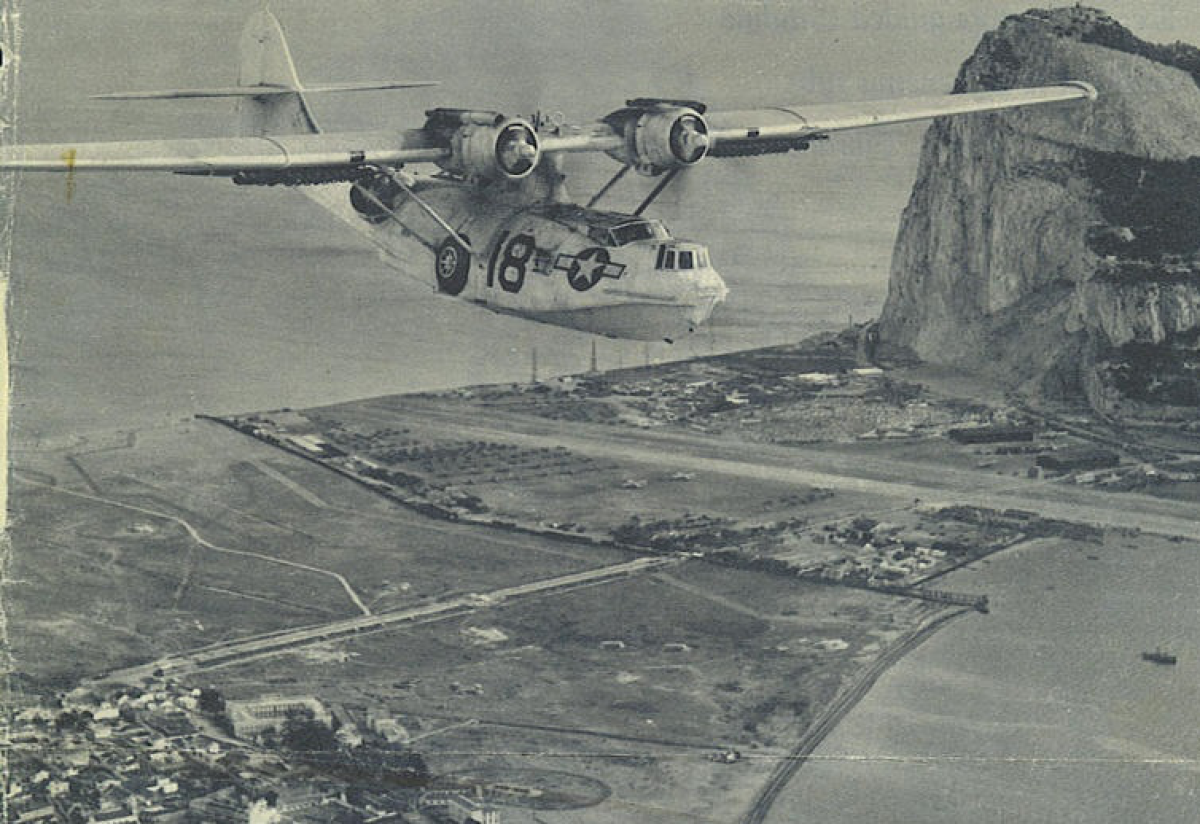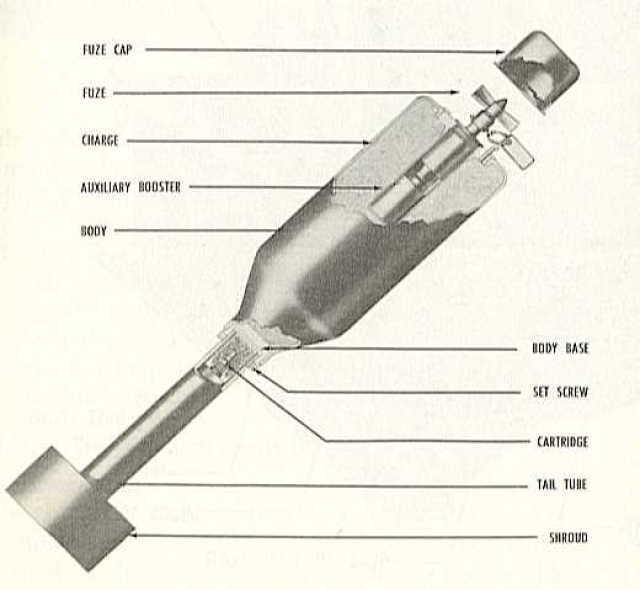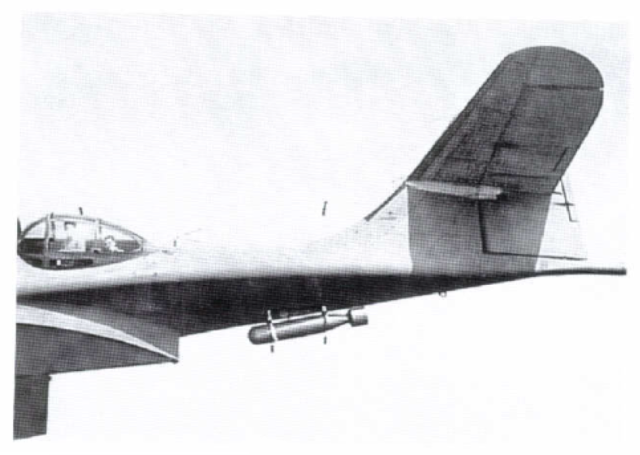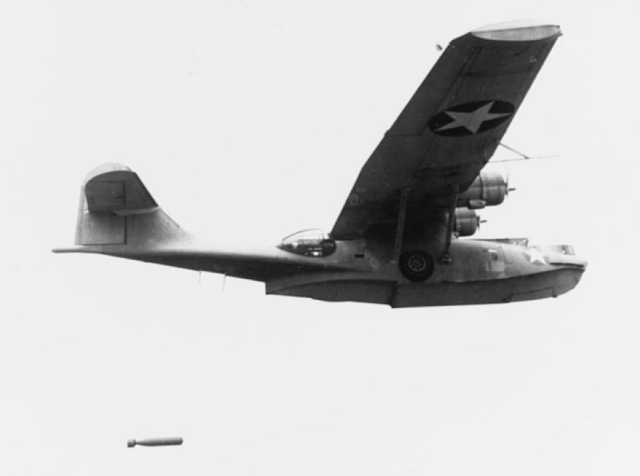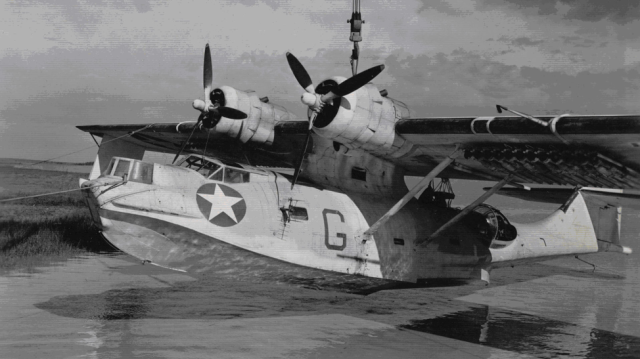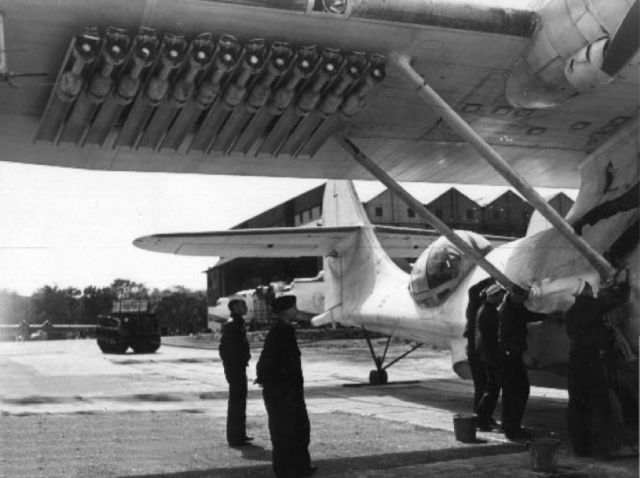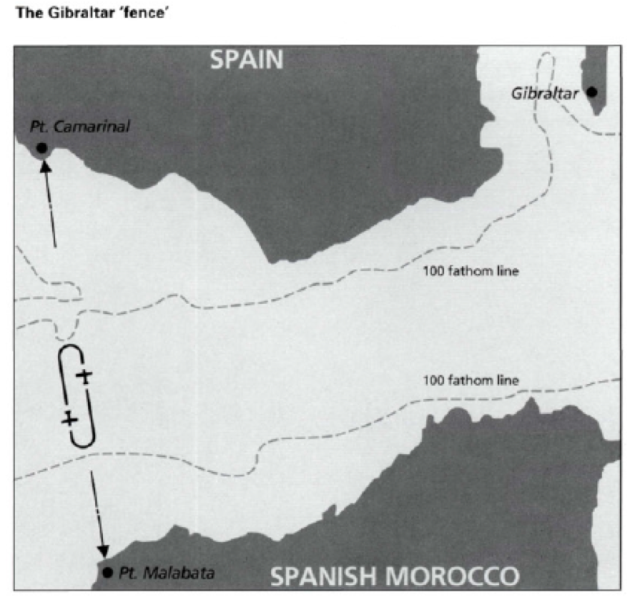Author’s note: The term “retro bomb” is used throughout this article in preference to the alternate “retrorocket,” which to the modern reader might cause confusion. The later term was often used at the time this weapon was in service, as a retrorocket as we know it today had yet to exist.
On 24 February 1944, Patrol Squadron VP-63 scored their first victory against a German U-boat, marking almost two years of development and use of their unique weapon, the retro bomb. Two of their PBY Catalina aircraft drove U-761 to the surface and forced its abandonment off Gibraltar.
Weeks after the United States entered World War II, U-boats appeared off the East Coast and began wreaking havoc on merchant shipping. The U.S. Navy was looking for new solutions, as well as tried ones, to end this disaster.
One new solution was the use of magnetic anomaly detection, or MAD. This device detected variations in the Earth’s magnetic field due to the presence of a large iron object near the detector that caused distortions in the field. A plane flying over a submarine using a MAD device would detect its presence by this distortion. At the time, the U.S. Navy put great faith in the ability of MAD to find submarines. It was the their latest "secret" invention.
But the Navy lacked a weapon that could be used with MAD to attack a submarine after it was found. Division 3, Section L, of the National Defense Research Committee (NDRC) and Office of Scientific Research and Development (OSRD) at Caltech received the task of developing one. Richard C. Tolman, professor of physical chemistry and mathematical physics headed the project with his deputy, Charles C. Lauritsen, professor of physics.
Because a MAD detection would not occur until the aircraft had flown over its target, the weapon would have to be launched so that it fell absolutely vertical and behind the aircraft. This would allow the bomb to fall directly on the position of a MAD detection and attack the submarine. Using conventional bombs and depth charges meant they fell well ahead of the target instead of on it due to the plane’s motion. The solution Caltech came up with was the retro bomb.
Laursiten’s solution was to use the existing model of the Anti-Submarine Rocket (ASR) “Mousetrap,” a 7.2" rocket developed from the earlier Hedgehog spigot bomb, fired in retrograde. That is, launched backwards from the wing of a naval patrol plane. The Consolidated PBY-5A Catalina, the Navy’s most common patrol plane, would be used.
The Mousetrap rocket had been in design and testing at Caltech since September 1941 and was being tested at Goldstone Dry Lake about thirty miles north of Barstow California (part of Fort Irwin today). This made the modification into the retro bomb quick and simple.
The retro ASR needed a larger motor to match the forward velocity of the Catalina, so this was increased in size from 2.25” diameter to 3.25.” That would give the retro bomb the necessary 400 ft/sec speed to counter forward motion. The explosive warhead remained 60 lbs. and was armed on the operational model by a hydrostatic fuze similar to those used on depth charges. The weapon did not arm until it entered the water and began to submerge increasing its safety while on the carrying aircraft.
To test the weapon, engineers from Caltech set up a rig at Goldstone Dry Lake using two telephone poles forty feet apart with a rectangular multiturn coil of heavy wire hung between them powered by car batteries and a DC generator. This simulated the magnetic signature of a submarine and allowed the MAD detector on the PBY to “find” it. On 3 July 1942 several test runs were made before the PBY dropped one its retro bombs directly onto the test rig damaging it. These tests have the distinction of being the first time a rocket was fired from a U.S. combat aircraft.
The aircraft mounting consisted of two dozen retro bombs mounted on the wings of a PBY. A shallow metal trough served to guide the launch and protect the wing of the plane. Later, the mountings were increased to 30 per plane.
Three different motors were developed for the operational rocket, based on the expected speed of the aircraft. The 7V6 for 205 mph, the 7V7 for 200 mph, and the 7V8 for 400 mph. By the time the retro bomb went into operational use, the explosive warhead replaced TNT with Torpex, a more powerful explosive. These retro bombs were designated 7V11 and 7V13 and standardized in May 1943.
VP-63 and the operational use of the retro bomb
With success of the testing, a Patrol Squadron of PBY Catalina was formed to use MAD and retro bombs. Designated VP-63, the squadron was organized at NAS Alameda, California, on 19 September 1942. They were quickly dubbed the “Mad Cats” from their use of the MAD detector and flying PBY Catalina, or "Cat," patrol planes, a common nickname for this aircraft.
The method VP-63 developed was when a submarine was detected, a smoke/light float would be dropped to mark the sub’s position. Multiple passes established the direction of the sub. This allowed an accurate attack to be made.
A PBY’s crew initiated the attack based on the MAD readings. The retro bombs fired automatically via a circuit connected through the MAD instrumentation. The launch system fired the bombs in a rectangular pattern to increase the likelihood of a hit.
VP-63 moved to the NAS Quonset Point, Rhode Island, on 3 March 1943 where they were assigned to Air Anti-Submarine Development Center Atlantic (AirASDevLant) for operational testing of MAD and the retro bomb.
Parts of the squadron were assigned to separate locations along the U.S. East Coast to begin operational sorties on 21 April, looking for U-boats off the southeastern Atlantic seaboard and Florida.
The squadron quickly discovered their equipment had serious limitations. The operational altitude for MAD was limited to under 400 feet, and frequently the planes were flying at 50 to 150 feet to detect U-boats. Formation flying at very low altitude by four or more planes abreast roughly a quarter mile apart became normal practice. MAD worked, locating a half-dozen shipwrecks, but it was too short-ranged to randomly find a submarine other than by sheer luck.
VP-63 also traded their amphibious PBY 5As for PBY 5s that lacked landing gear. It was found that the extra weight of the landing gear made the plane marginally airworthy when carrying MAD gear and retro bombs.
On 7 June, the squadron moved to Iceland. Unfortunately once there, they had no better luck locating a submarine. In late July 1943 they moved again to Pembroke Dock, South Wales, to fly patrols over the Bay of Biscay.
Lieutenant (jg) Parker made the squadron’s first contact on 29 July, spotting two U-boats running on the surface. When the U-boats submerged, MAD proved too short-ranged to track the boats.
In December 1943 the squadron moved again to Port Lyautey, Morocco, to fly patrols off Gibraltar.
At Port Lyautey, VP-63 changed commanders. The new commanding officer, Lieutenant Commander Curtis Hutchings, decided to implement a different strategy.
The squadron was now patrolling the area off the Atlantic side of the strait of Gibraltar to prevent U-boats entering the Mediterranean Sea. A fast current in the strait allowed a submerged U-boat to ride it into the Mediterranean almost without using its engines. This made the passage nearly silent, and the submarine extremely hard to detect using sonar.
VP-63’s MAD equipped Catalinas gave an excellent alternative. Hutchings planned to seal the strait by setting up a continuous patrol across the deepest parts using his aircraft. This aerial barrier became known as “the Fence.”
The squadron’s Catalinas flew "the Fence" at approximately two-minute intervals continuously from sunrise to sunset at an altitude of 100 to 150 feet in the deeper part of the strait between Point Matabata in Spanish Morocco and Point Carmarinal in Spain. Additional planes patrolled further out into the Atlantic to force any U-boat present to remain submerged during daylight.
The idea was to keep a U-boat submerged in daytime and unable to enter the strait riding the current while also keeping it from charging its batteries. If the sub tried to use its electric motors in shallower water, it could be found by ships using sonar. If, instead, it tried to make a submerged daytime passage the PBY’s with their MAD would find it. If it waited until night, the U-boat’s batteries would be depleted, forcing it to make the passage on the surface where Royal Navy ships could counter this. "The Fence" went operational on 8 February 1944.
Success came 16 days later. On 24 February, at 1500 hours, Lieutenant (jg) T. R. Wooley in P14 and Lieutenant (jg) Howard Baker in P15 made a MAD contact and began to mark its track with smoke floats. The pilots notified the Royal Navy and Lieutenant Commander John Wallace commanding HMS Anthony and HMS Wishart raced to the location at high speed, scattering the carefully placed smoke floats.
Wallace, an experienced sub hunter on Atlantic convoys, made a sonar search for the sub. Finding nothing, he told the planes that they were tracking a school of fish and that his ships found nothing on sonar.
The PBY crews asked the ships to leave and began to reestablish contact. By 1557 they had a new track and at 1559 dropped retro bombs on it. The retro bomb explosions got the attention of the Royal Navy ships, still nearby. They returned to the scene, dropping depth charges.
Minutes later U-761, commanded by O. Lt. Horst Geider, surfaced and his crew began to abandon ship. The British ships picked up 48 survivors, including the captain.
Initially, Wallace claimed his ships caused the damage that sank U-761 and wanted credit. O. Lt.Geider however, contradicted him stating that the retro bombs crippled his sub and forced it to the surface. VP-63 and the retro bomb had their first success.
Less than a month later, on 16 March 1944, VP-63 aircraft assisted the HMS Vanoc and HMS Affleck sink the U-392, all hands were lost. This time, MAD found the sub but the planes did not get to use their retro bombs.
On 15 May 1944, the squadron scored their second success using retro bombs. Lieutenant A. L. Worrell in P14, and Lieutenant (jg) Vopatek in P1 made a MAD contact at about 1530 and launched a 30 retro bomb salvo. The anti-submarine trawlers HMS Blackfly and HMS Kilmarnock used the smoke float marker line to make depth charge attacks as well. Two explosions resulted from the retro bomb attacks and VP-63 was credited with sinking the U-731, the entire crew was lost.
The last success using retro bombs was on 20 April 1945 when Lieutenant F. G. Lake on patrol over the Bay of Biscay sighted a submarine’s snorkel and flew up its wake. He delivered a 30 retro bomb pattern on the resulting MAD contact, sinking U-326. This was the last time the retro bomb was successfully used in combat.
Out of dozens of patrol squadrons the U.S. Navy operated in World War II, only VP-63 used the combination of MAD and retro bombs. The squadron proved the combination could work, but only in special circumstances.
MAD worked, provided the aircraft could get close to the location of a submarine. False positives, like shipwrecks, and the need for multiple passes using smoke floats slowed the engagement rate. The retro bomb, likewise, could only be effective when the target submarine’s location was known with a high degree of precision.
The combination of a need for precision, short range, and the slow engagement rate worked against the retro bomb—MAD combination. This was made worse by post-World War II submarines being much faster when submerged. MAD survived as a sensor, and is still used in hunting submarines today supplementing such systems as sonobuoys.
The retro bomb, born out of expediency in wartime and developed very quickly. It filled a need but was too specialized to have a wide success. VP-63 with determination and the correct set of conditions showed it could work. But better alternatives were developed. Declared obsolete shortly after World War II ended, the retro bomb was replaced by more flexible weapons like the homing torpedo.
1. Roscoe Creed, PBY: The Catalina Flying Boat (U.S. Naval Institute Press: Annapolis, 1985).
2. Norman Friedman, U.S. Naval Weapons (Conway Maritime Press: Greenwich, UK, 1983).
3. RADM Curtiss Hutchings, USN (ret), The MAD Cats of Patrol Squadron Sixty-Three (Naval Air Museum Foundation, 1984).
4. Andreas Parsch, The Retrorocket, Directory of U.S. Military Rockets and Missiles, Appendix 4: Undesignated Vehicles.
5. Conway W.Snyder, "Caltech’s Other Rocket Project: Personal Recollections," in Engineering and Science Quarterly, Spring 1991.
7. Location of Naval Aircraft, Op-40-A-KB(SC) A6-4/VZ, U.S. Navy official, various dates between 1942 and 1945.
8. U-326, U-392, U-731, and U-761, accessed May 2018
9. Porte-avions et Aéronavale accessed May 2018
10. U-boat Archive accessed July 2018



